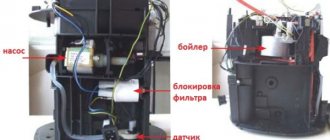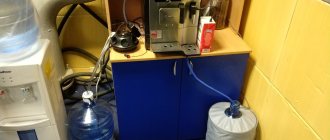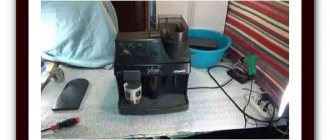It is worth noting that a fully automatic coffee machine is a reliable assistant that will pamper you with a cup of coffee in the morning, as well as give you your favorite drink during the day at the office.
Disassembled coffee machine
At the same time, for a longer service life of the device, it is worth constantly carrying out preventive measures, and also learning how to repair the coffee machine with your own hands.
By the way, the repair of the coffee machine will depend on whether Delonghi, Saeco, Krups or Siemens is on the consumer’s table, since their technical characteristics and functions are different.
Coffee machine repair
It is worth clarifying that the repair of any model, including Siemens, will also be associated with typical problems identified for all types of units.
DIY Delonghi coffee machine repair
It is worth noting that repairing Delonghi coffee machines with your own hands can be done in the shortest possible time. The fact is that repairing a Delonghi coffee machine is associated with the following features:
- oversaturated with electronics;
- a huge number of sensors;
- availability of control systems.
Unit repair
Repairing a Delonghi coffee machine with your own hands allows you to fix minor problems, but to fix the most serious problems you will have to contact professionals at a service center.
It is worth noting that the Delonghi coffee machine may experience malfunctions that:
- breakdowns that you can actually fix yourself;
- failures and problems with units that are repaired at the center.
By the way, you can easily repair a Delonghi coffee machine yourself if:
- When pouring a drink, the stream flows too thin or a hissing sound is made;
- coffee does not prepare even when heating and drawing liquid;
- There is a leak from under the Delonghi coffee machine.
Real coffee
Problems with a Delonghi coffee machine can be associated with low-quality coffee beans, incorrect operation of the unit, wear and tear of parts and components. That is why you should carefully read all the provisions of the instructions, and also use only water passed through the filter and clean the waste compartment in a timely manner.
You should not try to fix Delonga problems on your own, such as:
- malfunction of the heating element or boiler leakage;
- problems with the electronic board;
- problems with the hydraulic pump;
- Thermoblock malfunction.
Delonghi Nespresso capsule coffee machine
It is possible to repair the following yourself in Delonghi:
- hissing when pouring a drink - the filter horn is clogged - clean it with detergent;
- Coffee does not brew when water is drawn in - there is an air lock - pass the water through the cappuccino maker;
- water leakage from under the housing - wear or drying of the sealing rings - replacement of this part.
Coffee with croissant
A selection of coffee machine faults.
Hello everyone, I decided to post assorted photos of coffee machine malfunctions. There will be a photo, then a few words about what you just saw.
Philips Saeco multivalve reducer. I don’t remember which one exactly. The valve began to leak, the gearbox with the motor is located under the valve, it is flooded and rotted. In general, a “marketing ploy” by engineers)
Krups. That says it all. The silicone coffee outlet tube moves with the piston, and over time the plastic tube into which the silicone tube fits broke off. As a result, coffee comes out of all the cracks, but not into the cup)) If Krups has normal machines, I haven’t seen them. I have never seen anything more stupid than these machines in a technical sense. Everything was done “to choke”!
Phillips saeko. Emergency pressure valve. Again a “marketing ploy” by the engineers. The plastic is thin, the spring is strong, from the vibration pump, and the discharge tube is bent into a bullish one. The thinnest part couldn't stand it.
I turned out the remains only with the help of some mother.
Since through this tube the water is discharged directly into the pan and does not come into contact with drinking water or coffee, it is possible to create a collective farm. The metal tube is the elbow of the telescopic antenna from the radio receiver)
Ready. It sealed perfectly.
Philips saeko x-small. Water did not flow into the brewing unit. You just need to do decalcification on time. The whole car was filled with such pieces of calcium. The photo shows the coffee/steam valve.
Old lady Yura stood in some basement for probably 10 years. Life had already begun in her) Enterprising people decided to restore her.
The brewing unit, like that of cereals, is not user serviceable, no one washed it.. I had to wash it and lubricate it. I didn’t dare drink coffee from it)
Mileage. Odometer type)
Some Bosch, I don’t remember. The PCB under the triac of the coffee grinder burned out and shorted. When plugged into the socket, the coffee grinder immediately worked) Wire cutters and hanging installation according to GOST “snot” fixed everything)
Thank you all for your attention, ask questions, I will try to answer.
What model of coffee machine do you think
the most reliable one you can buy for your home?
I join the question
Delonghi ECAM 22.110.SB Magnifica S is relatively inexpensive and, in my opinion, worthy of any kitchen.
A coffee machine technician is needed in Rostov-on-Don. The poor guy is standing in the office, working on his last legs.
Friends have this godless Philips Saeco, it worked for a year and they were already repairing the brewing unit. I have a Delonghi 3200 for 5 years, the flight is normal, the main thing is not to be lazy and, in addition to draining the water and throwing out waste, wash the brewing unit, and also do decalcification during the process.
Saeko has been working for us for almost 7 years, without any lags. Need to rinse more often
I will show this thread to clients so that they know that it’s the car that needs to be cleaned, and not the “manufacturer’s wank”)
Good afternoon. Can you tell me if the Philips Saeko coffee machine started to wake up/appear a lot of coffee under the brewing unit, what could it be?
Delonghi ECAM 3000 V is also normal, they are approximately in the same price range.
Delonghi ecam any of this series. Wash, maintain, lubricate more often, read the instructions, do not turn on without water and coffee and this will last you a long time.
Please tell me, delonghi esam 2600, started scattering work inside the case. In other words, the pressed and spent coffee tablet crumbles when the brewing unit tries to dump it into the waste container. First, according to the instructions, I left the brewing unit in water for 20-30 minutes, which was enough for literally a couple of days. We drink a day
2 cups of coffee. About a month ago I disassembled the entire brewing unit, washed it and lubricated it with silicone grease (which came with the Phillips coffee machine), as a result, now it’s scattering coffee again.
What could it be? Crooked hands, crappy lubrication, or am I missing something?
1 leaking thermoblock (for service)
2 replace both rings on the piston
3 clean the valve and mesh in the piston
4 reduce grinding
5 information search engines on the Internet
How do I understand all these problems with coffee machines “press and done”?
How to repair a Saeco coffee machine yourself
By the way, it is possible to repair a Saeko coffee machine with your own hands at home, taking into account such features of the equipment as the ability to completely disassemble it, providing full access to the components.
Do-it-yourself repair of a Saeco coffee machine may be absolutely necessary if you service it carelessly or incorrectly, use coffee beans of poor quality and unacceptable varieties, or configure the settings incorrectly.
Because Saeko is a delicate unit, repair of a Saeko coffee machine should in most cases be entrusted to professionals. However, repairing a Saeko coffee machine with your own hands is available if necessary:
- eliminate plaque on the walls;
- clean the cappuccino maker;
- restore the backlight on the switch;
- eliminate noise and vibration during operation.
Cozy coffee
In order to eliminate plaque and scale on the walls in Saeko, you should watch the corresponding video, and then use branded liquids and tablets. At the same time, you can clean the Saeco cappuccino maker using the same products, not forgetting to rinse the system afterwards for safety.
You can talk about self-solvable problems with a Saeco coffee machine if:
- water does not flow out of the device;
- coffee is heated only to room temperature;
- The mechanical component of the unit does not work.
Coffee machine Saeco lirika
How to disassemble
Part of the answer to the question of how to disassemble a coffee machine looks like this: you should definitely stock up on a screwdriver with a long thin slot, various bit attachments, and, if available, capes for unscrewing hexagons; thin pliers will also come in handy. In general, the process looks like this:
- The back wall is freed from the mounting screws. They can be very different - with a cross, hex key, asterisk, recessed, with a semicircular or flat head.
- If you cannot release the back panel, you should inspect the structure for the presence of latches. They are bent with a long slotted screwdriver.
- After the walls are freed, they can be disassembled further; the process depends on the specific model of the product.
Some coffee machines give access to most components after removing the back panel. Others will have to be examined more thoroughly. For example, for Saeko machines the complete process looks like this:
- First, the front panel is opened and the waste containers and coffee dispensing unit are pulled out.
- The mug stand is dismantled and moves forward along with the tray.
- The water container is removed from the rear; after removal, access to the bean compartment lid opens.
- To dismantle the coffee storage compartment, you need to unscrew all the fastening screws and carefully pull it out.
- Another mounting screw needs to be removed under the container.
- Dismantling continues from the front panel; there are a couple more fasteners there, accessible from below.
- Behind the bean compartment there is a final, deeply recessed mounting screw.
- When removing the top panel of the coffee machine, you need to disconnect the water supply hose.
- Dismantling is completed by removing the front door.
Main components of the Saeko coffee machine
After such disassembly, you can get to all components of the device. This will make it possible to inspect, clean and lubricate the mill mechanism, and check for voltage at key points in the electrical circuit of the Saeco coffee machine.
Features of DIY Krups coffee machine repair
Unlike the Saeco available for review, Krups will have such qualities as danger due to a voltage of 220 Volts, which feed the components and heating elements. This is why repairing a Krups coffee machine for beginners is dangerous due to the risk of electric shock.
Do-it-yourself coffee machine repair will be required if the consumer:
- treats the device carelessly;
- use water of high hardness or poor quality;
- allow critical voltage drops;
- allow the presence of scale;
- dropping the coffee machine from the table onto the floor;
- Do not allow coffee capsules to get stuck in the machine.
Coffee machine in the kitchen
Do-it-yourself repair of a Krups coffee machine is possible:
- Krups coffee machine creaks unnaturally - problems with the coffee grinder mechanism;
- Krups is leaking - urgently disconnect the unit from electricity - replace the damaged tube or valve;
- refuses to brew cappuccino - there are problems with the cappuccino maker and it requires thorough cleaning;
- descaling required;
- It is necessary to replace sensors or clamps, gaskets and tubes.
Flavored coffee
However, if the Krups coffee machine does not brew coffee or does not do it according to the recipe, then you should contact a service center for diagnostics. And you certainly shouldn’t repair Krups yourself if you need to replace the electronic board or display.
In what cases is it better to contact the service?
You definitely need to contact the help of a service center when the Delonghi coffee machine does not work due to damage to a part that requires replacement. It is impossible to repair the electronic components of the car yourself - the control unit, sensors. High-pressure hydraulic system components are difficult for unqualified repairs:
- boiler thermoblock;
- hydraulic pump;
- tubes and valves with seals.
The service technicians will have a diagnostic tool and the ability to take the necessary spare part from the warehouse or order it from a catalog. The most important thing is that an experienced repairman is thoroughly familiar with the machine’s structure and common problems, so he understands how to act.
General Security Issues
If you decide to independently examine the coffee maker and carry out repairs, then you should take basic safety measures:
- The device must be disconnected from the network.
- You need to work with a tool with insulated handles.
- Water and wet hands are a source of potential danger.
It is not difficult to disassemble the body of most coffee makers. Often it is enough to unscrew a few screws on the back cover. This makes it possible to gradually disassemble the device into units or large parts. At the same time, there are subtleties: on DeLonghi machines, the bolts located on the bottom are closed with plugs or are located under rubber feet, and many Saeko models additionally require the removal of fasteners to remove individual blocks, allowing access to the areas needed for repair.
To avoid mistakes, please refer to the reference information. If the coffee maker does not lend itself to logic and cannot be understood, it is better to look for data on the model on the Internet.
Many devices, in addition to the screws on the back of the case, also have latches that hold the top cover or bottom.
To find such fasteners, you will need a thin screwdriver or a knife, which is used to pass the line of the joint of the parts to the localization of the area where you can press the latch.
Coffee grinder VES 730 or unfinished repair experience
I show the appearance of the device after many years of use with a photograph.
Manufacturer's warranties: what is important to consider
The VES 730 coffee grinder is produced by the Spanish manufacturer from Barcelona, Rotwein. SL She clearly warned all buyers in her technical documentation (operating instructions): the service life of the device is set at five years.
Please note that this is not a warranty resource, during which any breakdowns will be repaired free of charge. Here we are talking about a completely different period. This is clearly visible in the photograph. There is a footnote at the bottom with the text enlarged.
Working conditions: how the instructions were followed
Grinding of beans occurs by striking a pile of coffee beans with rotating knives with sharpened cutting edges. The high speed of rotation of the rotor and sharp blades break them into smaller parts with each revolution.
These coffee grinders are designed for very fine grinding of coffee beans: literally into dust. This property allows them to prepare a drink for brewing in a Turk: the Turkish way for certain lovers - coffee lovers.
My VES 730 coffee grinder was successfully used for two years longer than the specified period. She was also subjected to other stresses. She had to grind not only coffee beans, but also seeds of other plants. Spices were often crushed to season first courses and meats:
- dill;
- caraway;
- coriander;
- sweet bell pepper and black pepper.
But we didn’t crush the sugar into powder. There was little point in this operation. And this mode is the most destructive for knives and the engine.
It is worth noting that my VES 730 coffee grinder successfully coped with all the loads created, and the manufacturer’s recommended standards for filling the working chamber and the operating time of the electric motor were not always observed.
In other words, the temperature regime of the stator and rotor windings was periodically violated, but I never brought it to a critical state. This did not affect the insulation of internal circuits and engine operation. The power of 150 watts declared by the manufacturer turned out to be optimal for such loads.
I conclude: the electrical characteristics of the VES 730 coffee grinder are ideally suited to work in our conditions.
Internal structure of coffee makers
The basis of a coffee maker is a water container and a heating element, but then there are differences. The difference between a drip coffee maker and an espresso is described by the operating pressure. In the first case, boiling water simply drips onto the filter containing poured coffee, the drink penetrates further down, flows down, and fills the cup. It is important to create a drop-stop function so as not to actively collect water. In espresso, a stream of water at a temperature of 95 degrees is released under pressure, forced through the pill. To top it off, a special press dries the juice. A dry squeezed coffee pill comes out. There is no need to install any additional filter. Coffee machines operate on different principles; there are drip and espresso models.
Capsule coffee makers contain a brewing compartment with a needle into which a plastic container with coffee powder is inserted. Brewing can be done under pressure or without. The first method differs from the second in the presence of a boiler in the design: the water reaches the desired temperature, the compressor creates pressure. In the latter case, we often look at the possibility of getting milk foam. Stable bubbles are formed due to steam at the highest temperature. The walls of the balls are hardened by high heat. One difference between brewing coffee and getting foam:
Coffee is brewed with water at 95 degrees Celsius; to produce steam, the heating elements work, reaching a threshold of 127 degrees. The modes are considered the best for conventional recipes.
Pay attention to the compressor: it allows you to properly boil the coffee and get foam. The pressure created is impressive, reaching 15 - 20 bar, more than what is supplied to the radiator system in the fall, checked during technical measures. It manages to boil coffee perfectly. Espresso models (sometimes called carob models) have a special horn into which the coffee is poured. Then the structure is screwed onto the body pipe, and the handles are tightened with force. What comes out is a compacted pill through which water is powerless to flow, without the compressor circuit having the highest power. It is possible to boil good coffee, which is not sufficiently different from the real drink acquired by the Turks using accepted, conventional methods.
We describe in detail the structure of the coffee maker, the types of coffee makers, so that readers can imagine what is happening inside. Knowing the operating features of the devices, it is easy to localize the breakdown. The main types of defects will visit the mind automatically, and the internal structure will become natural.
Drip coffee maker: principle of operation
We are writing the operation of a drip coffee maker. Water is taken into the container through a hose and pumped out with a pump. The flow heater produces a fixed power, the pump speed is coordinated with the output temperature. Smart coffee makers have a sensor that monitors the characteristics of the environment. Bypassing the tube, the burning water reaches the upper compartment, equipped with a filter, containing ground coffee. The dose is carried out according to the flow meter evidence, or a temporary pump relay limits the duration of the heating element’s activation. Possible adjustment. A spring timer operates by energizing the pump through a spark relay, or an electrical board monitors the flow meter readings and stops the water supply at the appropriate time.
In some cases, the temperature is not monitored at all. A portion is taken through a non-return valve. Then the heating element turns the liquid into steam in a matter of seconds, the stream rushes upward through the tube, flooding the brewing compartment and flows into the cup. The technique does not allow you to get real coffee, but it is notable for its simplicity of implementation. The coffee maker knows how many microdoses one cup can hold. A simple manual counter controls operation. The absence of water in the tube for the new intake is controlled by a bimetallic plate. In a simple case, the heating element immediately works over a volume of water equal to a standard cup of coffee.
The drip coffee maker has an hourglass shape and is powerless to prepare cappuccino or latte foam. Repairing drip coffee makers yourself is simple. Inside we will find:
- a heating element;
- water pump;
- control circuit.
There is an electrical interior of the microcircuits - there is a switching power supply that produces a constant voltage of the required rating (+5, +12 V). Efficiency increases. To measure temperature, a bimetallic plate is used, which breaks very rarely. Let's simply check the check valve by blowing in one or the other direction. The engine is running, controlled by a temporary relay (ordinary RC chain), less often we see a flow meter and a level sensor. The pump rings, if the engine is a collector, the action is repeated for sections alternately.
Carob (espresso) coffee maker: principle of operation
Repairing a carob coffee maker seems more difficult. There is not a pump - a compressor that pumps water under pressure into the boiler. The heater is located outside the tank. From the outside it resembles an iron: the heating element is rolled to the wall of a collapsible boiler. To regulate the temperature there is a bimetallic plate; the tension of the sensor is adjusted with a screw for at least 2 positions. To brew coffee, a temperature of 95 degrees Celsius is used; steam production requires 127 degrees. Accordingly, the heating element relay contact opens at the appropriate moment. The boiler is strong, assembled in 2 halves, and can withstand pressure of 20 atm without any problems. The entrance is equipped with a return valve so that the water does not flow back during thermal expansion and heating.
The engine is designed to dispense a fixed portion of water. The coffee maker is called a carob coffee maker because the coffee is poured into a cup with a long handle. The design is pressed onto the body, and the coffee is compacted. Under pressure pumped by the pump, water fills the mug. Coffee makers are considered the best, experts say: carob models will allow you to extract the maximum taste and smell from the beans.
Inside carob coffee makers there is one engine, which belongs to the pump. Switching the path to steam supply is done manually. A commutator motor is used occasionally, the pump is relatively small, there is no point in gardening, there is a lot of noise. The pressure is pumped up by a piston (like a refrigeration compressor), so there is no need to develop enormous force. It’s easier to save copper and use an asynchronous engine. Brushes take up a lot of space. Carob-type coffee makers are equipped with power supplies for the motor and other parts.
Expensive models contain an engine compatible with inverter control. There are valve ones. A special feature of horn models is the presence of a boiler bypass valve. The pressure is metered, ensuring the correct brewing process.
Capsule coffee makers: operating principle
Capsule coffee makers are not sufficiently different from drip coffee makers. A small container containing coffee powder is placed inside, and the piercing mechanism is manually clamped. After use, the capsule is automatically reset and removed by the user of the device. Inside, the movement of water flow is controlled by a pump; an instantaneous water heater raises the water temperature, reaching a given temperature. Sometimes there are no sensors, the pump just operates according to a timer. The rate of water transmission is calculated in advance. All that remains is to substitute the cup. If water is not dosed correctly, look for a power source for the pump motor. The time circuit is faulty, no matter how the interval was set.
Repairing a coffee maker with your own hands does not really depend on the model. Saeko, Gaggia, Nespresso, Rowenta, Spidem - differ in details. Shape, placement of parts, types of sensors. The principle of action remains the same everywhere. Repairing Jura coffee makers is similar to repairing Krups coffee makers.
The inspection begins along the cord along the power board, if there is one. The pulse source is provided with a cascade of filters, a diode bridge, and main transistors. Elements before and after the transformer are inspected for burnout and checked. It’s easier to immediately measure the output voltage of the circuit and move on later. It is easier to check the pump separately. Before doing this, look at the voltage rating required for the power supply to avoid any mishaps. If the pump breaks down, the possibility of winding the stator coils is assessed. There is a chance to successfully complete the operation; you will not have to take the newest part.
Mastergid - homemade products at home and in the country.
The coffee machine is leaking or leaking
Water is leaking from under the coffee horn, accumulating under the coffee machine, the O-rings should be checked. Often, ground coffee, grease and dirt get underneath them. The seal is broken and steam escapes. For DeLonghi models, the instructions draw the attention of buyers to careful handling of coffee machines. Their water accumulates in the pan and under the machine itself.
Open the housing, remove the coffee brewing unit and check the O-ring. Remove it, wash it, clean the entire unit and reinstall it. If cracks form on the ring, you need to buy a new one. To do this, you should take your passport to a specialized store. Rings from equipment from other companies will not fit. They will be rougher or softer, of different sizes.
The horn filter should be washed. If it is clogged, steam coming under high pressure finds its way out in a weak spot. By analogy, the brewing unit in a coffee machine is checked and all tubes are cleaned.
Leaks must be repaired in a timely manner. There is a lot of electrical equipment inside the car. If water gets on it, a short circuit to the housing and electric shock may occur. At best, the motor or board will burn out.
Problems with high pressure pumps
The leaders in the problem of fluid supply failure are models with VT1513 and VT1511. These are extremely convenient coffee makers that operate under a pressure of 16 atmospheres and allow you to prepare delicious espresso. However, the slightest discrepancy in grinding, as well as the use of hard water, can cause problems with the liquid supply.
When using too fine grinding, the Vitek VT1511 and VT1513 models clog the meshes and filters. If you use too large, the drink will not brew. Hard water causes clogging of high pressure pipes. And all this leads to serious damage - failure of the injection pump or splitting of the plastic switch block.
Vitek VT1513 coffee maker pump
To carry out maintenance or repairs, you must first disassemble the device:
- The top aluminum cover, where the cups are located, is removed.
- Look for the mounting screws hidden under the rubber pads.
- The screws are removed and the back cover is removed, giving access to all components.
You can immediately see areas of potential breakdowns. High pressure tubes are hard and thin. The feed switch is a small plastic block that the distributors fit into. The supercharger is a round metal pump. To repair a Vitek coffee maker you will need:
- Assess the condition of the high-pressure tubes, check their fixation points - there should be no looseness or cracks.
- Check the condition of the blower housing. Splits or signs of overheating indicate a possible pump malfunction.
- Inspect the condition of the feed switch.
If, after assessing the reliability of the contacts, the problem is still not clear, carry out the following operations:
- Clean high pressure pipes. To do this, you can use thin rubber tubes or single-core wire in soft insulation. There is also a special tool - a flexible brush.
- Check the fasteners and contacts, remove all dirt.
- Clean the filters.
After which the coffee maker starts up and is re-checked for the functionality of the components. By the way, the most common accident is a crack in the switch; it is determined by the presence of water on the surface of the part. The damage cannot be sealed (pressure will squeeze out any sealant). Therefore, it is worth replacing the block or simply melting the crack by heating a knife or screwdriver on a gas burner.
Vitek VT1513 mode switch failure
If disassembling, cleaning, and visual inspection of the coffee maker did not allow you to localize the problem, most likely the problem is in the supercharger, and you need to call a specialist.










